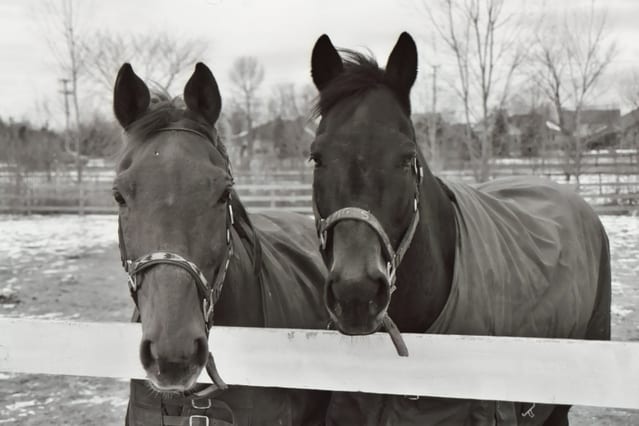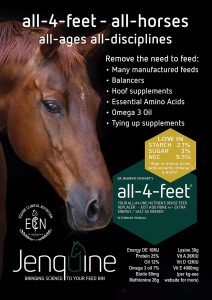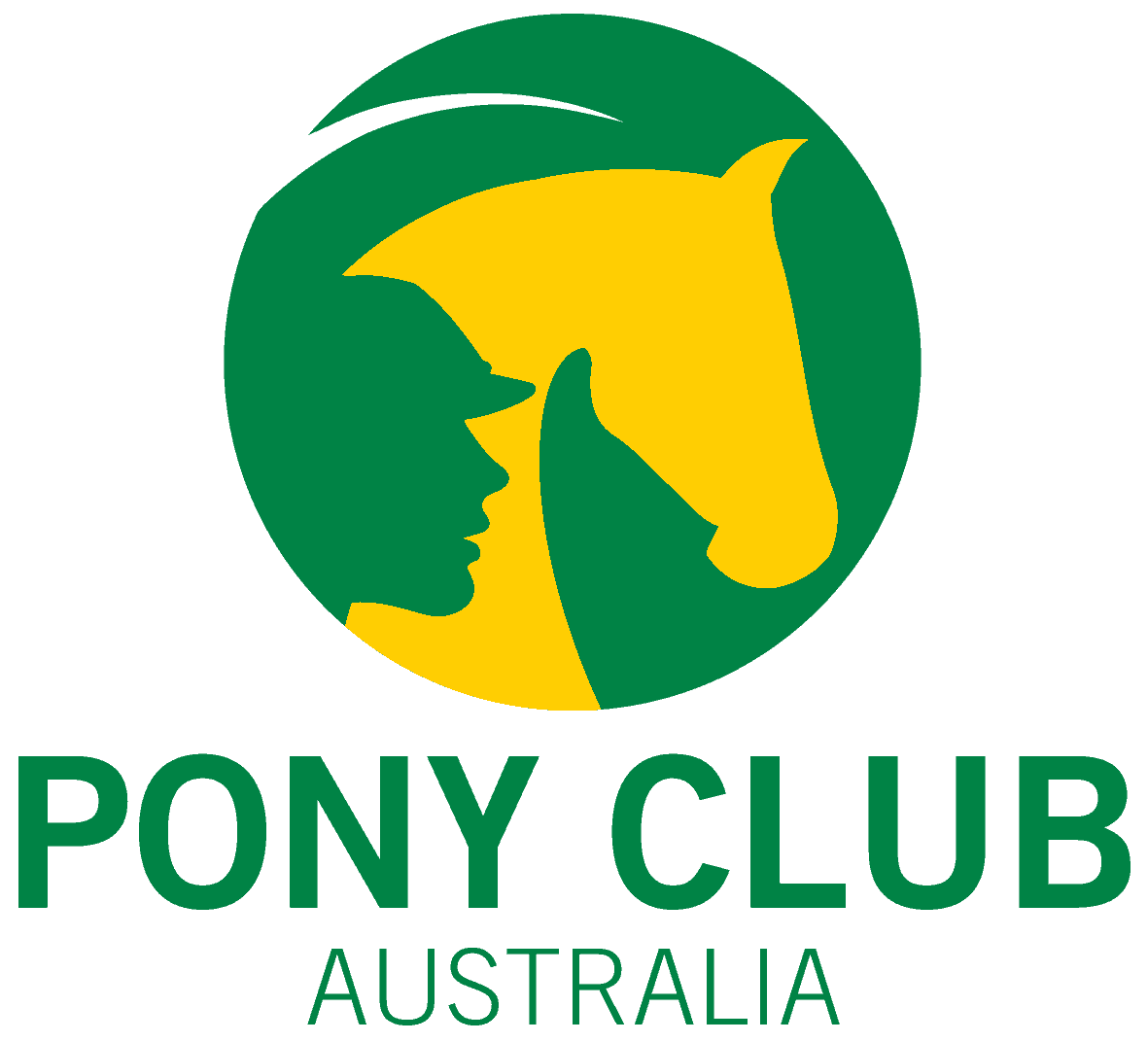When we look at our horses huddled in the cold together, tails to the wind and rain, we wonder how to help them keep warm and cosy over the cold months. Feeding management in winter needs to be different to summer feeding.
Feeding for warmth
Rugging is an option but well-fed horses can thrive even in temperatures well below zero. What feed is best for keep your horse warm inside? Roughage! Hay, pasture, beet pulp, soyhulls and chaff all generate lots of warmth as they are digested in the gut, generating three times as much body heat as oats or corn. This really does help your horse stay warm inside and they don’t need to shiver until the outside temperature drops to minus 8C. So make sure they always have plenty of roughage – and if they eat it all, give them more.
Oats, oil and beet pulp for energy
Shivering uses up lots of energy as the muscles under the skin shake to produce heat. Winter grasses are usually low in energy and your horse might need more energy so they don’t lose weight. Thin horses need more energy because they lack insulation and clipped horses begin to shiver when the temperature is 10 – 15 °C higher than those that have a thick coat.
A fluffy, furry coat winter coat can mask thinness and weight loss, so it’s important to regularly run your hands over your horse.
There are several ways to increase energy – an extra dipper of oats, some beet pulp and/or oil. If your horse tolerates oats, you can add 300-500g to their daily feed and see how they respond over 2-3 weeks and whether you need to increase or decrease this amount. Beet pulp has as much energy as oats and is a great probiotic. 300ml of oil has as much energy as 1kg of oats and linseed oil has lots of benefits. Depending on the size of your horse, start feeding around 50ml a day and gradually increase over 2-3 weeks then reassess.
Soymeal and lucerne for protein
When horses lose weight and topline, they lose fat and muscle. Muscle building and maintenance needs protein and the best sources are lucerne and soymeal so include these in the daily feed to prevent muscle breakdown and loss over winter.
Vitamins and minerals
If hay is older than three months, some vitamins will be lost especially vitamins A, D and E. A pellet that contains vitamins, minerals, biotin, iodine, selenium and amino acids is recommended as it means you don’t need three or four supplements to meet each nutrient requirement.

Photo by Stephanie Slinger from FreeImages
A warm bran mash?
Impaction colics are more common in winter. To encourage drinking and keep the gut moving nicely, water should be between 2 – 10°C. The warm smell of bran freshly mixed with hot molasses promises comfort and contentment. But bran contains poor quality protein and is only 12% fibre – the same as oats – making bran a low fibre supplement and expensive for the poor quality nutrition it provides.
Loose manure the day after a bran mash is due not to a laxative effect, but to the sudden change in diet which induces a low grade digestive upset by irritating the gut wall and compromising the bacteria in the large intestine.
Bran should be restricted to less than 10% of the diet as it contains nine times as much phosphorus than calcium.
Bran is also high in phytates which bind calcium, preventing absorption. An occasional bran mash is not harmful, but a separate calcium supplement may be necessary. Other pellets and feeds that provide vitamins, minerals and protein can be softened to a warm mash that is just as yummy and warming.
DISCLAIMER: All content provided in this article is for general use and information only and does not constitute advice or a veterinary opinion. It is not intended as specific medical advice or opinion and should not be relied on in place of consultation with your veterinarian.
More information on equine nutrition is available at www.jenquine.com
Meet the author and PCA’s resident equine nutritionist
Dr Jennifer Helen Stewart
BVSc BSc PhD Dip BEP MRCVS
Equine Veterinarian and Consultant Nutritionist – CEO Jenquine

Dr Jennifer Stewart is an equine veterinarian with over thirty five years’ experience. She is also a consultant nutritionist and has formulated feeds, custom mixes and supplements for leading international horse feed manufacturers in Australia, India, Ireland, Japan, New Zealand, Philippines, South Africa, Thailand, Turkey and the UAE. Dr Stewart is passionate about equine nutrition and its role in the management, treatment and prevention of many equine diseases. She is committed to bringing ‘science to the feed bin’.
Dr Stewart graduated BSc (vet) and BVSc at the University of Sydney. Her research thesis was “Resistance of Equine Strongyles to Benzimidazole Anthelmintics” and her PhD “Studies on Heart and Lung Function in Foals”. She worked at the Universities of North Carolina, Michigan and Florida USA in equine medicine, antibiotics and exercise physiology. Following this was a time spent in Newmarket and Cambridge England, in stud and race track research and practice, before establishing an exclusively equine practice on the Central Coast of NSW Australia. She has been an official veterinarian for the Australian Jockey Club for over 20 years, was one of the team of equine veterinarians for the Sydney 2000 Olympic Games and consultant nutritionist for Mitavite for 10 years.
Dr Stewart has spent over twenty five years working on collaborative research projects into gastrointestinal and exercise physiology with major Universities; lecturing and supervising university and TAFE students; consulting to veterinary practices, trainers, pony clubs, owners, equestrian centres and studs; speaking at seminars in Australia, Middle East, South Africa, Philippines, SE Asia, Hong Kong, Japan, Turkey, India and New Zealand, and writing regularly for equine industry magazines. This experience in research, equine medicine and veterinary practice has given Dr Stewart a deep understanding of the complexities of equine health and performance; growth and development of young horses, and feeding practices for the management and prevention of diseases.
Watch Dr Stewart talk about her first love of horses and why she chose to become a vet in this short clip. Pony Club Australia is grateful for Dr Stewart preparing this laminitis article for our Horse Resource page. Please browse her other articles, blog and resources at Jenquine.



